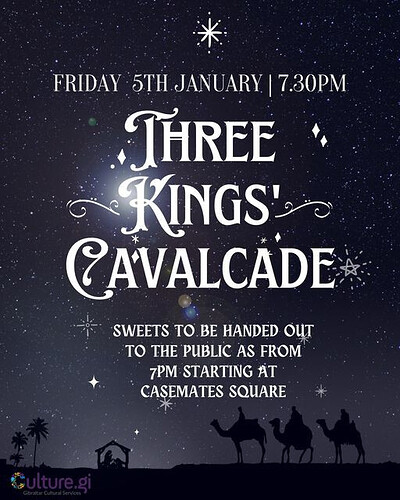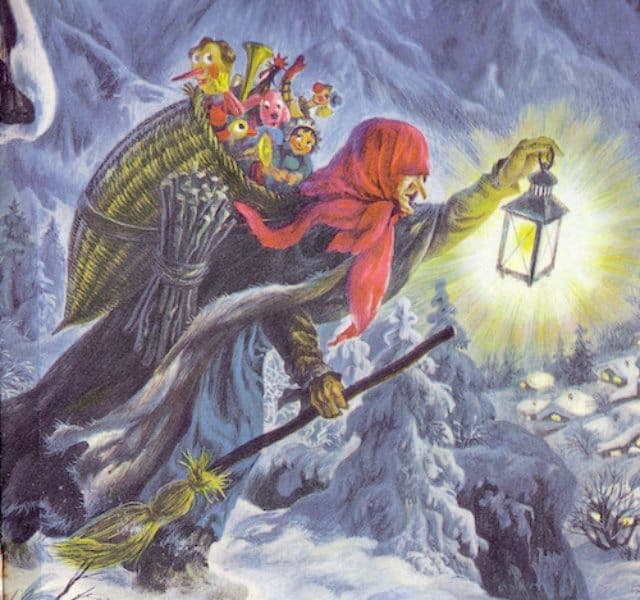Three King's Day concludes the Christmastide celebrations in much of the world.
January 5th is the 12th Day of Christmas; and January 6 is "Three King's Day" or "Epiphany."
It's huge in Spain (and Italy). On the eve of Epiphany, children lay their shoes out for gifts, representing when the three wise gave Jesus their gifts.
EuroNews of Three King's Day 5 years ago (1.21 min)
With the Spanish cultures influence in Gibraltar, it is also celebrated on The Rock – Three Kings' Cavalcade 2023 - 369/2022 - Government of Gibraltar
7 Pagan Holidays Adopted by Christianity
In Italy, the Epiphany is held in the highest regard and is seen as the most important day of the holiday season. Yes, that means it even out places Christmas. In Italian culture, most families do not exchange gifts on Christmas like many other parts of the world, but instead, they wait until January 6th to give gifts. This is because that is when it is believed that Befana — a witch — rides around on her broom and gives gifts to the good children and coal to the naughty ones.
Sounds familiar, right?
But the Pagan origins of the holiday do not have anything to do with a witch flying over the country and handing out gifts or coal, but it was still important to the Ancient Romans. To the Romans, January 6th was celebrated following the twelve nights after the Winter Solstice. During this time, it was believed that the Roman moon goddess Diana was accompanied by the personifications of satiety and abundance.
These deities would fly over the fields and make them fertile for the year ahead. They believed that the year ahead was the personification of an old lady who would use her last breath to give food and seeds to Italy’s people to provide for them throughout the year. This is where the legend of Befana came from for Italian children, which is, of course, very similar to Santa Claus as well!
From a wizard Santa to a Witch
Weaving a witch into the three kings story:
Befana is usually portrayed as a hag riding a broomstick through the air wearing a black shawl and is covered in soot because she enters the children's houses through the chimney. She is often smiling and carries a bag or hamper filled with candy, gifts, or both.
Legend had it that Befana was approached by the biblical magi, also known as the Three Wise Men a few days before the birth of the Jesus. They asked for directions to where the Son of God was, as they had seen his star in the sky, but she did not know... blah blah blah
Fables for Truth.
As Christianity slowly replaced Germanic paganism during the Early Middle Ages, many of the old customs were gradually lost or assimilated into Christian tradition. By the end of the High Middle Ages, Germanic paganism was almost completely marginalized and blended into rural folklore], in which the character of Frau Hulda eventually survived.
Based on analysis of church documents and parishioner confessions, it is likely that the spirit identified by the Church as Diana or Herodias was called by names of pre-Christian figures like Holda a Germanic goddess of the winter solstice.
Frau Holle's festival is in the middle of winter, the time when humans retreat indoors from the cold. It may be of significance that the Twelve Days of Christmas were originally the Zwölften ("the Twelve"), which like the same period in the Celtic calendar were an intercalary period during which the dead were thought to roam abroad.
Clearing Up The Wise Men's Story
By the time the 3 wise men made it to Bethlehem, Jesus was a child.
Matthew 2:1 Now when Jesus had been born in Bethlehem of Judaea in the days of Herod the king, behold, there came wise men (druids) to the East to Jerusalem,
2:2 Saying, Where is he that has been BORN King of the Jews? for we saw his "Star" in the East, and are come to worship him.
2:3 When Herod the king had heard [these things], he was troubled, and all Jerusalem with him.
In the Irish version of the Gospel of Matthew we are told that Druids came to the East to worship the King of kings. Britain was ruled by the Levitical Druid religion and the word Druid means Truth, their motto being "The Truth Against the World". Glastonbury was a Druid centre of learning and there was an observatory on the summit of Tor Hill for the study of astronomy. They were waiting for their Messiah Yesu/Hesus – Jesus (the Truth made flesh) - to come. In other words the real true Druids were the Levitical priesthood of the ten "lost" tribes of Israel, in exile. – Glastonbury - Summerland
2:11 And when they were come into the HOUSE, they saw the young CHILD with Mary his mother, and fell down, and worshipped him: and when they had opened their treasures, they presented unto him gifts; gold, and frankincense, and myrrh.
2:16 Then Herod, when he saw that he was mocked by the wise men, was exceeding wroth, and sent forth, and slew all the children that were in Bethlehem, and in all the coasts thereof, from TWO YEARS old and under, according to the time which he had diligently [and accurately] enquired of the wise men.
Jesus was born in the Spring - Lambs are born in the spring, not winter.
In the year 7 B.C. there was a conjunction of Jupiter (the king of the planets) and Saturn (thought to be the protector of Israel) in the Constellation of Pisces (the Sign of the Messiah), as computed in 1603 by the Astronomer Royal in Prague - Johannes Kepler, that was first visible at daybreak on the 12th of April 7 B.C. (Passover in 7 B.C. was on Monday April 13th which commenced at sundown on the 12th). The earth-shattering significance of this conjunction – Messiah; King; Protector of Israel; Passover - would have been unmistakable to the Levitical Druid astronomers in the British Isles, where the monarch was also the Archdruid. – Glastonbury - Summerland

